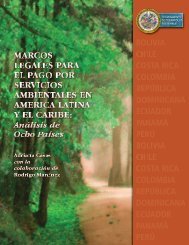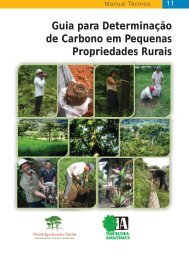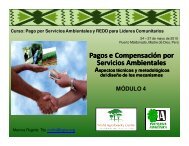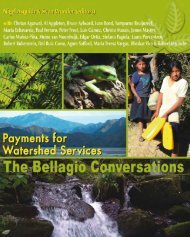Guide on Climate Change and Indigenous Peoples
Guide on Climate Change and Indigenous Peoples
Guide on Climate Change and Indigenous Peoples
- No tags were found...
Create successful ePaper yourself
Turn your PDF publications into a flip-book with our unique Google optimized e-Paper software.
integrated with other strategies such as disasterpreparati<strong>on</strong>, l<strong>and</strong>-use planning, envir<strong>on</strong>mentalc<strong>on</strong>servati<strong>on</strong> <strong>and</strong> nati<strong>on</strong>al plans for sustainabledevelopment. Further, l<strong>on</strong>g-term adaptati<strong>on</strong> toclimate change requires anticipatory acti<strong>on</strong>s,which would require c<strong>on</strong>siderable investment ofcapital, labor, <strong>and</strong> time <strong>and</strong> in many indigenousregi<strong>on</strong>s of the world, there are alreadyc<strong>on</strong>straints <strong>on</strong> resources <strong>and</strong> a lack of access totechnology (UNPFII, 2008).• Migrati<strong>on</strong>, irrigati<strong>on</strong>, water c<strong>on</strong>servati<strong>on</strong>techniques, l<strong>and</strong> reclamati<strong>on</strong>, changing where<strong>and</strong> at what elevati<strong>on</strong> plants are cultivated,livelihood adaptati<strong>on</strong> are <strong>on</strong>ly am<strong>on</strong>g the manytechniques that indigenous peoples employlocally to fight the double battle of biodiversityloss <strong>and</strong> adapting to climate change.NOTE: Pleaserefer to ChapterIV: Adapting to<strong>Climate</strong> <strong>Change</strong>:<strong>Indigenous</strong><strong>Peoples</strong> Showthe Way forshort-termadaptati<strong>on</strong>measuresundertakenby indigenouspeoples8How can biodiversity be used asa soluti<strong>on</strong> for climate change?• Protecting biodiversity should be seen as an essential comp<strong>on</strong>ent ofadaptati<strong>on</strong> to climate change. 6• Reducing deforestati<strong>on</strong> <strong>and</strong> other forms of l<strong>and</strong> use change can lead tothe reducti<strong>on</strong> of GHG emissi<strong>on</strong>s.• It provides a “safety net” of genetic resources for adaptati<strong>on</strong>.• It provides protecti<strong>on</strong> (bioshields) against the negative impacts ofclimate change.9How can soluti<strong>on</strong>s to climate changeaffect biodiversity? What should be d<strong>on</strong>eto c<strong>on</strong>serve biodiversity while mitigatingclimate change?• Better l<strong>and</strong> management <strong>and</strong> the use of marineprotected areas may be possible to prevent <strong>and</strong>even reverse the bleaching caused by rising seatemperatures. It could bolster the livelihoods ofmilli<strong>on</strong>s in the Caribbean, Pacific <strong>and</strong> Indian Oceans,who depend <strong>on</strong> the reefs for tourism income,seafood, <strong>and</strong> physical protecti<strong>on</strong> from storms <strong>and</strong>waves.• Better protecti<strong>on</strong> of native vegetati<strong>on</strong> in dry l<strong>and</strong>s104 <str<strong>on</strong>g>Guide</str<strong>on</strong>g> <strong>on</strong> <strong>Climate</strong> <strong>Change</strong> <strong>and</strong> <strong>Indigenous</strong> <strong>Peoples</strong>
















